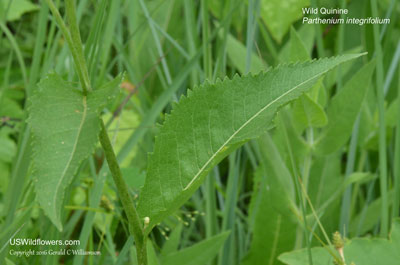Wildflowers of the United States | |||||||||||||
| |||||||||||||
Parthenium integrifolium - Wild Quinine, American Fever-few. | Parthenium is a relatively small genus of Asteraceae with about 16 species worldwide and 7 or 8 in the United States. The genus scientific name Parthenium is Greek for virgin, indicative of the white flowers. The genus common name Feverfew is indicative of its use medicinally, as is the common name of Parthenium integrifolium - Wild Quinine, which has been used in treatment for malaria. Parthenium integrifolium is the most widespread (or maybe only native) of the eastern Feverfew species, being found in 27 states from Texas and Oklahoma north to Minnesota and east to Massachusetts. It is not a deep south species, being found only in the northern part of the southern tier of states; absent from Florida entirely. Other than the introduced annual Parthenium hysterophorus (identified by pinnatifid or bipinnatifid leaves with the sinus extending almost to the midrib of the leaf), the perennial Parthenium integrifolium may be the only eastern Feverfew species, depending on how you classify the genus. Many authorities, including Weakley, consider Parthenium auriculatum - Glade Wild Quinine - found in 6 or 7 southeastern states - to be a separate species, but some (including ITIS and FNA) consider it to be a variety of Parthenium integrifolium. Weakley classifies Mabry's Wild Quinine as Parthenium integrifolium var. mabryanum, while ITIS and FNA do not consider it to be a separately recognized variety. There does seem to be relative consensus now, however, to consider Parthenium radfordii as part of Parthenium integrifolium, although those that accept var. mabryanum place it within that variety, while as previously mentioned, some do not accept that varietal level at all. Found in: AL, AR, CT, GA, IA, IL, IN, KS, KY, LA, MA, MD, MI, MN, MO, MS, NC, NY, OH, OK, PA, SC, TN, TX, VA, WI, WV, GS Leave comments on Parthenium integrifolium at this link.   Blue=Native; Grey=Introduced Map from USDA Plants Database: USDA, NRCS. 2017. The PLANTS Database (http://plants.usda.gov, 02 Jun 2025). National Plant Data Team, Greensboro, NC 27401-4901 USA. Search Our Database: Enter any portion of the Scientific, Common Name, or both. Do a general Google search of the entire site: #ad
| #ad
| | ||||||||||
|
Commercial / Cookie Notice Looking for Wildflowers for a specific state? Check here: | |||||||||||||
|
| |||||||||||||


